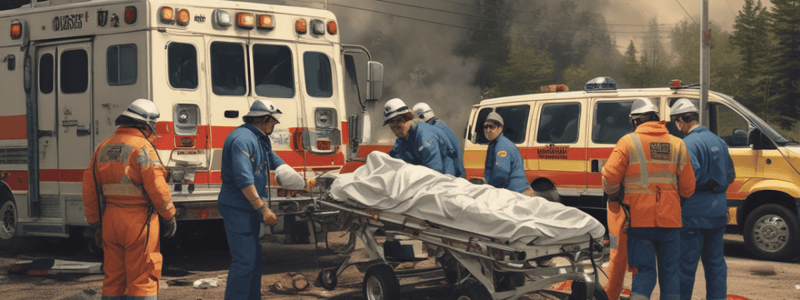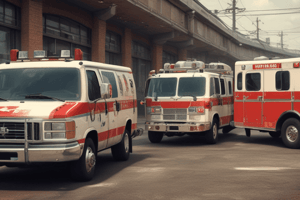Podcast
Questions and Answers
What is the primary goal of triage in the Emergency Department?
What is the primary goal of triage in the Emergency Department?
- To identify patients who need immediate surgery
- To categorize patients based on their diagnosis
- To decrease morbidity and mortality for all ED patients (correct)
- To assign an acuity level to patients based on their age
According to the Emergency Severity Index, what is the timeframe for seeing patients categorized as Level 3?
According to the Emergency Severity Index, what is the timeframe for seeing patients categorized as Level 3?
- Within 120 minutes
- Within 15 minutes
- Within 60 minutes (correct)
- Within 30 minutes
What is the first decision point in the Emergency Severity Index algorithm?
What is the first decision point in the Emergency Severity Index algorithm?
- Is the patient experiencing respiratory distress?
- Is the patient dying? (correct)
- Is the patient experiencing bleeding?
- Is the patient in severe pain?
What is the purpose of the primary assessment in the triage process?
What is the purpose of the primary assessment in the triage process?
How long should the triage time take according to the NEA Triage?
How long should the triage time take according to the NEA Triage?
What is the primary goal of the START Triage Algorithm in managing mass casualty incidents?
What is the primary goal of the START Triage Algorithm in managing mass casualty incidents?
What is unique about the JumpSTART Pediatric Triage algorithm compared to adult triage?
What is unique about the JumpSTART Pediatric Triage algorithm compared to adult triage?
What is the primary focus of the drills and exercises in operational management of mass casualty incidents?
What is the primary focus of the drills and exercises in operational management of mass casualty incidents?
What was the key takeaway from the full-scale exercise involving an improvised explosive device (IED) scenario?
What was the key takeaway from the full-scale exercise involving an improvised explosive device (IED) scenario?
What percentage of patients with potentially survivable wounds could have been saved, according to the exercise scenario?
What percentage of patients with potentially survivable wounds could have been saved, according to the exercise scenario?
What is the purpose of the START triage algorithm in a Mass Casualty Incident?
What is the purpose of the START triage algorithm in a Mass Casualty Incident?
What is the process for triaging patients using the START algorithm in a Mass Casualty Incident?
What is the process for triaging patients using the START algorithm in a Mass Casualty Incident?
What is the purpose of the colored acuity tags in the START triage algorithm?
What is the purpose of the colored acuity tags in the START triage algorithm?
What is the frequency of START Triage Training for emergency department nursing staff?
What is the frequency of START Triage Training for emergency department nursing staff?
What is the purpose of the management of Mass Casualty Incidents training?
What is the purpose of the management of Mass Casualty Incidents training?
What is the primary consideration when determining if a patient requires immediate intervention?
What is the primary consideration when determining if a patient requires immediate intervention?
Which of the following patients would be considered a high-risk situation?
Which of the following patients would be considered a high-risk situation?
What is the purpose of the Emergency Department Triage Decision Point B?
What is the purpose of the Emergency Department Triage Decision Point B?
Which of the following patients would require a 10-minute EKG?
Which of the following patients would require a 10-minute EKG?
What is the primary consideration when determining if a patient requires electrical therapy?
What is the primary consideration when determining if a patient requires electrical therapy?
What is the primary goal of the initial trauma assessment?
What is the primary goal of the initial trauma assessment?
What is the threshold for transporting children to a pediatric-capable trauma center?
What is the threshold for transporting children to a pediatric-capable trauma center?
What is a criterion for transporting a patient to a trauma center?
What is a criterion for transporting a patient to a trauma center?
What is assessed during the Across the Room Assessment?
What is assessed during the Across the Room Assessment?
What is the respiratory rate criterion for transporting a pediatric patient to a trauma center?
What is the respiratory rate criterion for transporting a pediatric patient to a trauma center?
What is the minimum pain rating for considering ESI level 2 criteria?
What is the minimum pain rating for considering ESI level 2 criteria?
How many resources are needed for a patient who requires an EKG and IV fluid hydration?
How many resources are needed for a patient who requires an EKG and IV fluid hydration?
What is a characteristic of compensated shock?
What is a characteristic of compensated shock?
Why is it important to weigh all children in the Emergency Department?
Why is it important to weigh all children in the Emergency Department?
What is a key difference between infants and children in the Emergency Department?
What is a key difference between infants and children in the Emergency Department?
What is the primary assessment sequence in the Trauma Nursing Process?
What is the primary assessment sequence in the Trauma Nursing Process?
What is the first step in the primary assessment of a patient with uncontrolled bleeding?
What is the first step in the primary assessment of a patient with uncontrolled bleeding?
What is the purpose of the LMNOP mnemonic in the Trauma Nursing Process?
What is the purpose of the LMNOP mnemonic in the Trauma Nursing Process?
What is the correct way to transport an amputated body part?
What is the correct way to transport an amputated body part?
What should be administered to offset the effects of potassium released when a tourniquet is released?
What should be administered to offset the effects of potassium released when a tourniquet is released?
What is the purpose of the A-J mnemonic in the Trauma Nursing Process?
What is the purpose of the A-J mnemonic in the Trauma Nursing Process?
What is the correct sequence of actions when applying a tourniquet?
What is the correct sequence of actions when applying a tourniquet?
What is the primary goal of the Patient Experience Nursing Bundle?
What is the primary goal of the Patient Experience Nursing Bundle?
What is the purpose of the IPASS component in the Patient Experience Nursing Bundle?
What is the purpose of the IPASS component in the Patient Experience Nursing Bundle?
What is the purpose of the hourly rounding component in the Patient Experience Nursing Bundle?
What is the purpose of the hourly rounding component in the Patient Experience Nursing Bundle?
What is the most common type of stroke?
What is the most common type of stroke?
What is the main cause of blocked or narrowed blood vessels in the brain?
What is the main cause of blocked or narrowed blood vessels in the brain?
What is a Transient Ischemic Attack (TIA) also known as?
What is a Transient Ischemic Attack (TIA) also known as?
What is the importance of identifying the signs and symptoms of stroke immediately?
What is the importance of identifying the signs and symptoms of stroke immediately?
What is the result of a blood vessel in the brain leaking or rupturing?
What is the result of a blood vessel in the brain leaking or rupturing?
What is the duration of a Transient Ischemic Attack (TIA)?
What is the duration of a Transient Ischemic Attack (TIA)?
What is the primary effect of fatty deposits building up in blood vessels in the brain?
What is the primary effect of fatty deposits building up in blood vessels in the brain?
What is the term for a temporary period of symptoms similar to those of a stroke?
What is the term for a temporary period of symptoms similar to those of a stroke?
What is the result of a blood vessel in the brain leaking or rupturing?
What is the result of a blood vessel in the brain leaking or rupturing?
What is the most common type of stroke?
What is the most common type of stroke?
What is the importance of identifying the signs and symptoms of stroke immediately?
What is the importance of identifying the signs and symptoms of stroke immediately?
Who can activate the stroke team?
Who can activate the stroke team?
Flashcards are hidden until you start studying
Study Notes
Mass Casualty Incident Preparedness
- Close ED walk-in and EMS entrances, decompress Kimmel Core, and move MCI equipment cards to the triage area
- All arriving patients enter through the Kimmel ambulance entrance, with mass decontamination and START triage algorithm applied as needed
START Triage
- A five-level triage instrument that categorizes ED patients by evaluating both patient acuity and needed resources
- Algorithm uses four decision points to sort patients into one of the five triage levels:
- Decision Point A: Is the patient dying?
- Decision Point B: Should the patient wait?
- Decision Point C: Resource need
- Decision Point D: Assigning an acuity level
Emergency Department Triage
- Objectives: identify patients who need immediate care, perform a brief primary assessment, assign an acuity level, and assign a location of care
- Primary assessment: subjective and objective data collection, including airway patency, breathing effectiveness, circulation effectiveness, disability, and environmental exposure
- Emergency Severity Index (ESI) categorizes patients into five levels, with Level 1 being the most critical and Level 5 being the least critical
Management of Mass Casualty Incidents
- Regular planning team meetings, hands-on mass decontamination training, discussion-based and operational exercises, and special event planning
- Training and education: START Triage Training, hands-on decontamination training, and structured walkthroughs
- Proactive decontamination team staffing and management of mass casualty incidents
Infectious Disease and High Consequence Pathogens
- Donning PPE: visually inspect, disinfect hands, coverall, boot covers, N95 respirator, gown, and face shield
- Measles addendum: a case was missed at NYULI, resulting in canvasing over 100 staff, patients, and visitors due to possible exposure
- Top 10 countries with high measles risk: Kazakhstan, Azerbaijan, Yemen, India, Iraq, Ethiopia, Kyrgyzstan, Russia, Pakistan, and Indonesia
Trauma Triage
- Simple Triage and Rapid Treatment (START) algorithm: a rapid and streamlined triage with two specific goals: speed and identifying who needs the most help
- JumpSTART Pediatric Triage: a slightly different START algorithm for pediatric patients, considering their higher degree of resilience and likelihood of survival with a long period of apnea
Trauma Nursing Care
- Trauma team structure and roles: communication, debriefing, and trauma assessment
- Across the room assessment: gathering informed observational data, including bleeding, breathing, appearance, and pain
- TDAP: definitive care or transfer to an appropriate trauma center
Shock
- Definition: unable to adequately perfuse tissues
- Stages of shock: compensated, decompensated, and irreversible
- Characterized by the buildup of lactic acid
Pediatric Triage
- Standardized approach: considering age, size, and developmental stage
- Infants and children cannot be evaluated through layers of clothing
- Stranger anxiety, heat and fluid loss, and hypotension as a late marker of shock
Stroke
- Definition: damage to the brain from interruption of its blood supply
- Types of stroke: ischemic, hemorrhagic, and transient ischemic attack (TIA)
- NYU time goals: door to attending physician evaluation (DAPT)
Studying That Suits You
Use AI to generate personalized quizzes and flashcards to suit your learning preferences.



